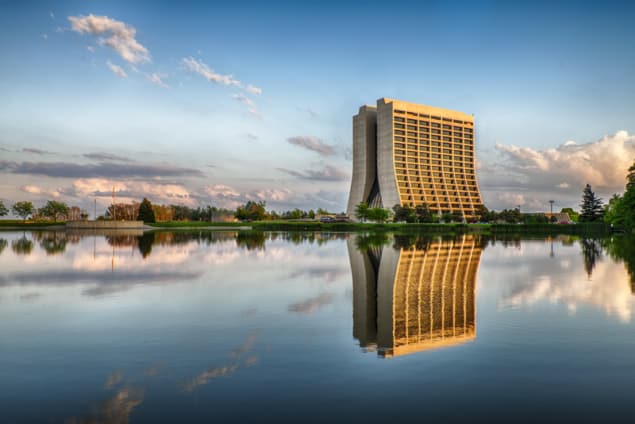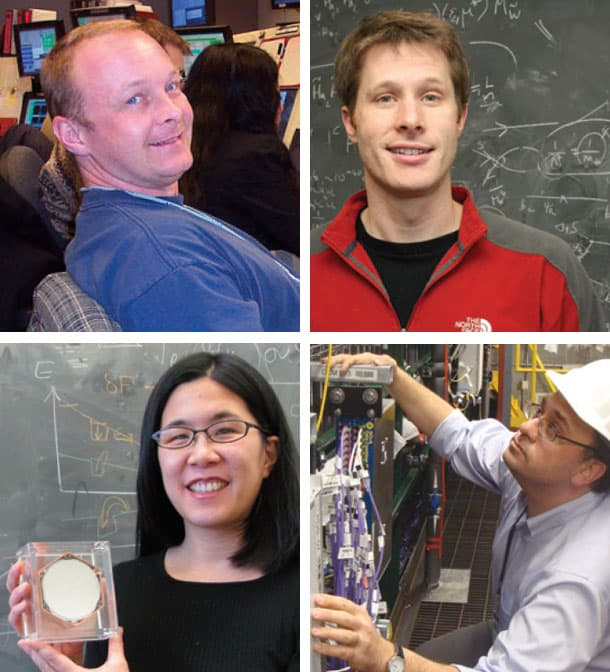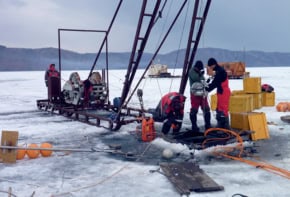With its Tevatron particle accelerator now closed for good, the Fermi National Accelerator Laboratory is shifting its focus from high-energy physics to experiments on the so-called intensity frontier. Margaret Harris visits the lab to learn more about its plans for the future

As I bump across the railway tracks and drive under the blue archway marking the entrance to Fermilab, the US particle-physics centre’s iconic Wilson Hall gleams like marble in the distance. Drive a little further – past the cluster of white farmhouses, the small herd of American bison, and the huge orange and blue warehouse that is home to one of the lab’s two high-energy-physics experiments – and the 16-storey structure appears to rise out of the flat Illinois landscape like a concrete cathedral. Up close, though, slight imperfections begin to emerge. A bit of scaffolding here. A blocked entrance there. And then, spilling out from the glassed-in atrium, I hear the muffled sound of drilling.
Wilson Hall, like Fermilab itself, was undergoing renovations when I visited in late 2011. But while the changes to the hall are cosmetic, those at the lab could be among the most profound in its 45-year history. On 30 September 2011 Fermilab’s flagship particle accelerator, the Tevatron, collided its last protons and antiprotons. The shutdown signalled the end of a 28-year run of discoveries at the veteran machine, including the top quark (spotted in 1995) and the tau neutrino (2000). It was also a quiet acknowledgment that, for the foreseeable future, the US has ceded its place on the “energy frontier” of physics to Europe, where CERN’s Large Hadron Collider (LHC) is busily churning out data in the search for the Higgs boson.
The end of the Tevatron does not, however, mean the end of Fermilab. “We have 10 accelerators here on site,” says Fermilab physicist Steve Holmes, with the merest hint of irritation. “We turned one of them off, okay?” Like several scientists I spoke to, Holmes was keen to point out that colliding high-energy beams of particles is not the only way of discovering new physics with accelerators. Another option, which Fermilab plans to pursue, is to look for rare interactions between particles at lower energies. In this type of experiment, the key parameter is not a beam’s energy but its intensity: the number of particles produced per second.
The intensity lottery
To understand why intensity matters, consider neutrinos. These mysterious, nearly massless entities are famously shy about interacting with other particles, so the more neutrinos an experiment can produce – by, for example, slamming a super-intense beam of protons into a graphite target – the better its chances are of detecting them. Other processes that are even rarer than neutrino interactions, such as the never-observed neutrinoless decay of muons into electrons, may also be detectable if the number of decays is high enough.
Bob Tschirhart, a Fermilab scientist who has worked on such “intensity frontier” experiments for 20 years, compares the hunt for rare decays to a lottery. “When you play the lottery, everyone knows your chances of winning are greater if you buy more tickets,” he explains. “The whole point of the intensity frontier is to have a large sample of decays, thereby buying more tickets in this lottery of very rare phenomena.”
For Fermilab, the shift in emphasis from high-energy to high-intensity physics is not so much a lottery as a calculated bet. With funding for science static or falling, and the LHC set to dominate high-energy research for the next decade and beyond, the lab is refocusing its efforts on projects that promise interesting results, require smaller teams of scientists, and take advantage of existing expertise in neutrino research and accelerator design. Holmes notes that these new projects are also unlikely to be outclassed by international competitors, since few other groups are pursuing this type of research. “This is an opportunity for the US to establish a leadership position in this very important area of physics that will last for decades,” he says. “If we do it right, we’ll just blow away the competition.”
Optimism abounds at Fermilab, and all the researchers I met there expressed excitement about the future (see “Voices from Fermilab” and audio clips). Even those still working on the Tevatron’s two detector experiments, CDF and DZero, seemed enthusiastic about performing their last analyses on the Higgs search and other goals, though they also mourned the old workhorse’s retirement. However, there are some potential hazards ahead, and it is never easy for a large organization to change course. Fermilab’s director, Pier Oddone, who has led the lab since 2005, acknowledges that he is still making the case for the lab’s new focus within the wider physics community. The funding situation is also unclear, with several planned intensity-frontier experiments still waiting for the US Congress or the Department of Energy to approve their budgets. A lot of time, effort and planning has gone into Fermilab’s shift towards the intensity frontier, but the odds on this bet are not entirely under the lab’s control. For the physicists working there, these are uncertain as well as exciting times.
Neutrinos in the limelight
Fermilab’s immediate future is unimaginably tiny, nearly massless and – from my vantage point 100 m underground, in front of the MINERvA detector – currently zipping through my body at (probably) just less than the speed of light. MINERvA sits squarely in the path of the neutrino beam produced when protons from the lab’s Main Injector accelerator collide with a graphite target. Bursts of several trillion neutrinos pass through it every 2.2 s. Despite its prime location, though, MINERvA is a bit of an unsung hero in neutrino physics. “The goal of MINERvA is really to understand the way neutrinos interact with lots of different nuclei all at once,” MINERvA co-spokesperson Debbie Harris explains as she shows me around the room-sized detector. To achieve this, MINERvA scientists have stacked thick “slices” of five different materials – carbon, iron, lead, water and helium – in front of a tank of liquid scintillator and a sensitive CCD camera. When a neutrino interacts with one of these materials, the resulting scattered particles produce telltale flashes of light in the scintillator, which the camera records. Data from these scattering events are important for many other neutrino experiments, Harris says, because the materials in the MINERvA detector are often the same ones that other experiments use. “We help them understand their data better,” she says proudly.
One Fermilab experiment that is benefitting from MINERvA’s results is MINOS, which sits just downstream from it in the NuMI (Neutrinos at the Main Injector) beam. Its location reflects one of the beauties of studying neutrinos: because the particles interact so rarely, it is perfectly possible to pile up multiple detectors in the same beam. MINOS, in fact, has two detectors: a near detector at Fermilab and a far detector deep inside the Soudan Mine in Minnesota, some 735 km away. This separation allows MINOS scientists to study how neutrinos change, or “oscillate”, between their different “flavours” – electron, muon and tau – as they travel through the Earth. At the near detector, almost all of the neutrinos in the NuMI beam are muon neutrinos. But by the time they reach the far detector 2.5 ms later, a tiny fraction of these muon neutrinos will have oscillated into electron neutrinos. The aim of MINOS’s paired detectors is to catch the neutrinos in this act of transformation.
The transformation from muon to electron neutrinos is associated with a parameter known as θ13, one of three “mixing angles” in a matrix that describes neutrino behaviour. While the other two mixing angles are known, θ13 is not, and measuring it is a major near-term goal of Fermilab’s intensity-frontier programme. Results from MINOS and competitors such as T2K in Japan and Double Chooz in France suggest that the value of a related number, sin22θ13, is greater than zero. However, the MINOS experiment is approaching the limits of its sensitivity, so it may not be able to pin down θ13 much further. Gina Rameika, a Fermilab physicist who has worked on several of the lab’s neutrino experiments, attributes this to the relative lack of knowledge about neutrinos when MINOS was designed in the mid-1990s. “Science wanders around,” she says. “You go down a certain path because it just seems obvious to do that. Then you learn something, and you end up heading down a different path. You don’t really know what you’re going to discover until you do the experiment.”
With that principle in mind, Fermilab is in the process of building a second long-distance neutrino experiment that will pick up where MINOS leaves off. Known as NOvA, the new experiment will incorporate a 200 tonne near detector at Fermilab and a 14 kilotonne far detector 810 km away in Ash River, Minnesota. The extra distance will make NOvA more sensitive than MINOS to muon-to-electron-neutrino oscillations, as will the decision to locate the far detector slightly off the neutrino beam’s axis, at an angle where the oscillations are expected to peak.
During my visit, Fermilab physicists and technicians were putting the finishing touches to NOvA’s prototype near detector. In late December 2011 their colleagues in Minnesota began assembling the “block pivoter” apparatus that will help them piece together the far detector. The entire $200m experiment is expected to be completed in 2014, with the first results due within the following year.
NOvA, however, is not the only new neutrino experiment in the works at Fermilab. An even bigger project, known as the Long Baseline Neutrino Experiment (LBNE), promises to do much of what NOvA can do, only better, while also answering some physics questions that NOvA will merely hint at. As LBNE project manager Jim Strait explains, knowing the value of sin22θ13 is really just the start. If, as current data suggest, it is not zero, physicists will be able to use the LBNE to search for a difference in the oscillation rates of neutrinos and antineutrinos. Such a difference would violate the Standard Model of particle physics, which incorporates a fundamental symmetry between particles and antiparticles, known as CP “charge–parity”) symmetry. Finding physics beyond the Standard Model would be exciting enough, but if CP violation were observed in neutrinos, it would suggest that these tiny, nearly massless particles could have tipped the balance between matter and antimatter in the early universe – thereby producing the matter-dominated universe we see today.
Current plans for the LBNE call for a new near detector to be built at Fermilab, with a far detector located 1300 km away in South Dakota’s Homestake mine. The cost of these detectors is estimated at $400–500m, depending on their design, and Rameika, a project scientist on the LBNE, says that construction could begin as early as 2014. If that happens, the entire project could be up and running by 2020, just as NOvA is winding down.
More power, more science
The LBNE’s timeline, however, depends on money. Funding is a perennial concern among US particle physicists thanks to Congress’s budgetary process, which allocates funds one year at a time. This can pose problems for projects such as the LBNE – and indeed Fermilab’s entire intensity-frontier programme – that take several years to complete. When I spoke to Oddone, funding for the LBNE and two other new experiments had already been held up for 16 months because Congress had delayed giving its approval to the fiscal year 2011 budget. Though such delays are not uncommon – to say budgets never get done on time “would be an exaggeration”, Oddone says diplomatically – the economic downturn and political gridlock in Washington has made the situation worse than usual. “A year and a half ago we were talking about doubling the budget for physical sciences,” Oddone says. “Today, people tell you that you’ll be lucky if you get the same amount of money you had in the previous year. The doubling has gone by the wayside.”
Oddone observes wryly that this is “problematic” for a laboratory in transition. Historically, though, funding problems have usually meant that projects get delayed, not cancelled. NOvA, for example, spent the first half of 2008 in financial limbo before Congress allocated it money to continue. So the LBNE seems likely to become a reality, though perhaps not as quickly as Fermilab’s neutrino physicists hope.
The outlook is fuzzier for an even bigger Fermilab experiment, known enigmatically as Project X. This $1–2bn linear-accelerator complex would be a real game-changer for the lab’s intensity-frontier programme, supercharging the LBNE while also delivering intense beams of protons to several other experiments. One of these will attempt to measure the electric dipole moment of neutrons and heavy nuclei; a nonzero value would violate CP symmetry. Others will look for evidence of rare processes in muons and kaons, such as the decay of a long-lived neutral kaon into a neutral pion, a neutrino and an antineutrino. The Standard Model predicts that this should occur only once in every 1010 kaon decays, so recording data on a large number of decays will give physicists a new way of testing the theory. The neutrinoless conversion of a muon to an electron is even rarer, occurring once in every 1017 decays at most. Theorists believe the process would be mediated by a particle so massive that even high-energy accelerators such as the LHC could never observe it directly. Looking for these muon decays is thus a roundabout way of studying high-energy physics, says Tschirhart, who is helping researchers develop proposals for Project X.
The design of Project X calls for two new linear accelerators, or linacs, to be built in the middle of the now-defunct Tevatron Ring, which has a circumference of 6.3 km (figure 1). The first linac will accelerate protons from rest up to 3 GeV and send 95% of them hurtling towards the rare-decay and heavy nuclei experiments. The remaining 5% of protons will enter the second linac, which will boost their energies up to the 8 GeV required to load protons into the existing Main Injector accelerator. Once in the ring, the protons will be accelerated to 120 GeV and slammed into a target, producing an intense shower of neutrinos that will make the existing NuMI beam seem like a trickle.
The design phase of Project X is expected to last until 2015 and Holmes, its project manager, says that construction could begin the following year “if the requisite funding is in place”. Tschirhart is upbeat about the chances. Funding agencies are currently supporting Project X’s development, he notes, and policymakers understand how important it is for the future of particle-physics research in the US.
Scientists working on the three beneficiaries of Project X’s intense proton beams – experiments on neutrinos, rare decays and heavy nuclei – will go ahead with their work even if Project X is delayed, and will initially use Fermilab’s current beamline. The loss of Project X would be a major setback for their research, though. “From my point of view, the LBNE without Project X is not something that I look forward to,” Rameika says. Project X, she explains, would send a 2.3 MW beam of protons to the LBNE’s target – more than three times as powerful as the NuMI beam, even after that beam’s imminent upgrade from 400 to 700 kW. Without Project X’s extra punch, she says, “we could literally be running for 30 years to make significant measurements. Science moves faster than that”.
Rameika notes that if Project X is delayed or cancelled, and LBNE physicists decide they cannot wait 30 years to accumulate sufficient data, they could consider building a larger detector. This would essentially compensate for the lower intensity by giving fewer neutrinos a bigger target to hit. However, a bigger detector would also be much more expensive, and “maybe I can afford 100 kilotonnes, but I cannot afford 300,” Rameika shrugs. Keeping costs down on the LBNE also offers opportunities for other experiments, she adds, since overall funding for particle physics is likely to remain constant.
Back to the frontier
In addition to securing funding for Project X, Fermilab will also have to overcome some technical challenges to build it. Here, the scientists I spoke to seem on surer ground, convinced that they can develop the tools and expertise they need to build this intense proton source.
One reason for their confidence is the Illinois Accelerator Research Center (IARC), a new $71m facility that is currently being built to support research, development and industrialization of particle-accelerator technologies. As its project manager Bob Kephart explains, IARC will help bridge the gap between having a great idea for using accelerators and putting that idea into practice commercially. Industrial-research experts commonly refer to this gap as the “valley of death” because so many ideas fall into it, and never progress any further.
As an example, Kephart cites the suggestion that an accelerator could irradiate sludge from wastewater-treatment plants, making it safe to use as fertilizer. “You might say, ‘Wow, this is a good idea’, but people thought about it in the 1970s,” he says. “The problem is that there are not a lot of accelerator experts in your average municipal waste-treatment plant. You need a product that is bulletproof. In fact, it better just have an on–off switch.”
When I visited Fermilab, construction workers with earth-moving machines were building IARC’s car park, and the lab later held a groundbreaking ceremony for the centre itself on 16 December 2011. IARC is being built with support from the Illinois state government, which is providing $20m for the 3900 m2 main building, while the Department of Energy has chipped in $13m to convert part of CDF’s $38m detector hall into a dedicated heavy-assembly facility. When it is finished in late 2013 or early 2014, IARC will provide 200 hi-tech jobs, and speakers at the groundbreaking ceremony touted its potential to make Chicago’s western suburbs a “world leader” in accelerator development.
This venture into applied and industrial science represents something of a new direction for Fermilab. “For years, our staff have been trained in how to turn dollars into research,” says Kephart. “What we need now [for IARC] is people who can turn research into dollars.” However, both he and Holmes, of Project X, stress that IARC will also benefit the lab’s particle-physics programme. The centre is expected to become a test-bed for superconducting radiofrequency (SRF) accelerator components, which will form the heart of Project X’s two linacs. In addition, partnering with private-sector firms to develop SRF technology should help drive down costs, Holmes says, making it more likely that Project X will gain Congressional approval.
A new flagship experiment such as Project X would be a significant development for this big lab on the Illinois prairie, with its proud tradition of doing science on several frontiers (see “The cosmic frontier”). But many here are looking still further into the future, and dreaming big. In addition to their scientific missions, Holmes says, Project X and IARC will help keep the US accelerator-science sector alive and healthy. Such investment could pay off handsomely for Fermilab when – or if – the international particle-physics community picks a location for next-generation facilities such as a successor to CERN’s LHC, a muon collider or a neutrino factory. For Fermilab, the energy frontier may be gone, but it is certainly not forgotten.
Voices from Fermilab
Brendan Casey
Fermilab physicist and collaborator on DZero and the muon g-2 experiment
The exciting thing now is that I’m designing a new detector, and I’ve never had an opportunity to do that before. Sometimes I have to force myself to step back and work on analysing Tevatron data because it’s so exciting to design a new detector from scratch.
Patrick Fox
Fermilab theorist
The switch to intensity-frontier experiments makes my job a little bit more interesting. It used to be that if I knew how an electromagnetic calorimeter worked, I could talk to somebody on CDF or DZero and at least have a lunchtime conversation about how they do their analyses. Now I have to understand how a neutrino detector works, how a kaon detector works, how a fixed-target machine works – all these things.
Lauren Hsu
Postdoc, Cryogenic Dark Matter Search
As a physicist, I think you face many challenges, from crawling around on the floor looking for cables that aren’t hooked up properly to spending a lot of time in meetings arguing about details. There’s just a huge range of things you have to do, and I think that’s what keeps our work interesting. We have to wear many hats.
Andrew Norman
Fermilab physicist and NOvA computing specialist
Computing is a tool that lets you access the physics. I love the mathematics of the algorithms, I love the challenges of the computing, and I love the physics that we’re doing. They all just naturally tie together to give a unified picture of what science is about today.
The cosmic frontier
High-energy and high-intensity physics are not the only subjects being studied at Fermilab. The lab also supports a research programme on the so-called cosmic frontier, participating in experiments that study cosmic rays, dark matter and dark energy.
DES
One such project is the Dark Energy Survey (DES). This successor to the Sloan Digital Sky Survey, in which Fermilab played a major role, will use the 4 m Blanco telescope at Chile’s Inter-Tololo Observatory to produce the biggest ever 3D map of the universe. Scientists working at the lab and 25 other institutions in the US, Europe and South America have built a new CCD camera and other upgrades for the 36-year-old telescope. The survey will take 10 years, with “first light” this April.
CDMS
Members of the Cryogenic Dark Matter Search (CDMS) collaboration use a suite of cryogenic germanium and silicon detectors to search for evidence of weakly interacting massive particles (WIMPs). Finding such particles would be a major advance in our understanding of dark matter – the mysterious substance that accounts for around 80% of the universe’s total matter – and also a boon for proponents of supersymmetry theories, which predict that WIMPs should exist. Fermilab is one of around 20 institutions participating in the experiment, which is located 800 m underground in Minnesota’s Soudan Mine. Such extreme depths are necessary to reduce interactions between the detectors and cosmic rays. In December 2011 scientists at Soudan began installing an upgrade to the existing detectors that will improve the experiment’s sensitivity by up to a factor of seven.
COUPP
The Chicagoland Observatory for Underground Particle Physics (COUPP), is exploring an alternative approach to WIMP detection that revives one of the oldest technologies in particle physics: the bubble chamber. COUPP’s updated bubble chamber consists of a quartz jar containing superheated liquid CF3I, and the idea is that a dark-matter particle passing through the liquid will cause it to boil, forming a particular kind of bubble that experimenters can detect. Since the experiment began in 2003, physicists working on COUPP have constructed a series of ever-larger bubble chambers to test the technology and determine its sensitivity to dark matter. In its current 60 kg incarnation, COUPP’s detector is located at Fermilab, nestled in the NuMI tunnel alongside the MINERvA and MINOS neutrino experiments. In May, a new, larger version will be installed at SNOLAB in Canada.






